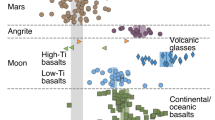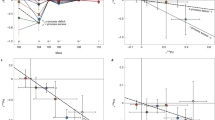Abstract
Latimer1 and Urey2 first investigated the oxidation states of iron in the dust phase of the solar nebula, demonstrating for the reaction  that the equilibrium constant K = H2/H2O is determined by the relative abundance of hydrogen and oxygen in the solar nebula. The equilibrium constant is further related to the standard free energy change, ΔG°, by the well known thermodynamic relation
that the equilibrium constant K = H2/H2O is determined by the relative abundance of hydrogen and oxygen in the solar nebula. The equilibrium constant is further related to the standard free energy change, ΔG°, by the well known thermodynamic relation  Thus, with ΔG° obtained from thermodynamic data and K determined by the solar H2/H20 ratio, the equilibrium temperature of ∼400 K is calculated.
Thus, with ΔG° obtained from thermodynamic data and K determined by the solar H2/H20 ratio, the equilibrium temperature of ∼400 K is calculated.
This is a preview of subscription content, access via your institution
Access options
Subscribe to this journal
Receive 51 print issues and online access
$199.00 per year
only $3.90 per issue
Buy this article
- Purchase on Springer Link
- Instant access to full article PDF
Prices may be subject to local taxes which are calculated during checkout
Similar content being viewed by others
References
Latimer, W. M., Science N.Y., 112, 101 (1950).
Urey, H. C., The Planets, (Yale Univ Press, New Haven, 1952).
Larimer, J. W., and Anders, E., Geochim. cosmochim. Acta, 31, 1239 (1967).
Anders, E., Acc. chem. Res., 1, 289 (1968).
Anders, E., A. Rev. Astr. Astrophys, 9, 1 (1971).
Cameron, A. G. W., Origin and Distribution of the Elements, (edit. by Ahrens, L. H.) (Pergamon, 1968).
Author information
Authors and Affiliations
Rights and permissions
About this article
Cite this article
HERNDON, J., ROWE, M. Meteoritic magnetite as a cosmothermometer. Nature 247, 531–532 (1974). https://doi.org/10.1038/247531a0
Received:
Issue Date:
DOI: https://doi.org/10.1038/247531a0
Comments
By submitting a comment you agree to abide by our Terms and Community Guidelines. If you find something abusive or that does not comply with our terms or guidelines please flag it as inappropriate.



